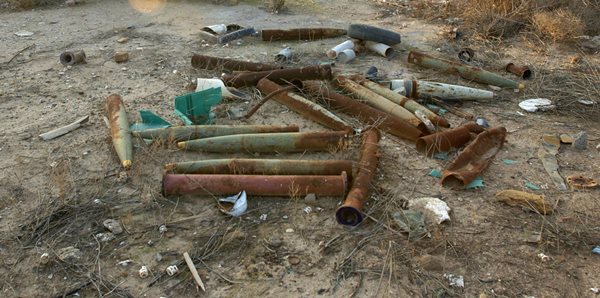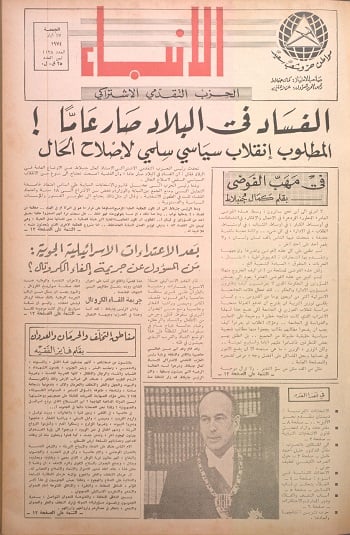A Deadly Legacy in Iraq
New York Times
16 أكتوبر 2014

Another chapter has been added to the dismal legacy of America’s involvement in Iraq. An investigation by C.J. Chivers, published in The Times on Wednesday, found that American and American-trained Iraqi troops discovered thousands of abandoned and highly dangerous chemical weapons left over from the rule of Saddam Hussein. These weapons, found from 2004 to 2011, wounded troops from both armies. There are now fears that some could fall into the hands of fighters for the Islamic State, which now controls much of the territory where the weapons were found.
These weapons are not the chemical and biological weapons of mass destruction that the George W. Bush administration claimed as the excuse for embarking on the Iraq war and that, it turned out, did not exist. Instead, they are aged remnants left over from an earlier chemical weapons program in the late-1970s and 1980s that was shut down in 1991. Mr. Hussein used the weapons against Iran in a war from 1980-88.
The investigation exposes shocking failings by the Pentagon, among them a callous disregard for the safety and care of American and Iraqi troops and a disturbing pattern of secrecy that can only erode public confidence in government.
Based on extensive interviews and documents obtained under the Freedom of Information Act, the report said that about 5,000 chemical warheads, shells or aviation bombs were found. On six occasions, soldiers suffered wounds; at least 20 American troops and seven Iraqi police officers were exposed to nerve or mustard agents.
When the United States sends troops into battle, it has an obligation to ensure that they are aware of potential threats and prepared to defend themselves. Not only did American intelligence not find the ready-to-fire weapons that were the false basis of the invasion, it and the Pentagon failed to prepare troops for the older munitions — often in hidden stockpiles of conventional weapons or in roadside bombs — they did come across over eight years.
It was not as if there were no warnings. In 2004, when a multinational Iraq Survey Group concluded that Iraq had not, in fact, had an active chemical weapons program for a decade, the group noted that American troops had turned up some old ordnance and predicted that more would be found. There was, moreover, this important fact: The weapons were designed in the United States, manufactured in Europe and assembled in production lines built in Iraq by Western firms. So there should have been a way for the American government to warn its troops of what might be out there.
Over the years, even as troops kept stumbling over these weapons, the discoveries were not shared publicly, and even in the military and Congress there were very few people who knew about them. Troops who came into contact with chemical weapons were told to keep the information secret. The result was to expose everyone else — soldiers and doctors — to further risk.
Unconscionably, some troops did not receive proper medical care or official recognition of their injuries in the form of medals.
There are still many unknowns, like is who was responsible for the cover-up and why senior officials and commanders allowed it to continue. Astonishingly, the Pentagon said on Wednesday that Defense Secretary Chuck Hagel had not ordered a review of the health cases of individual soldiers detailed by The Times.
The urgent task now is for the Obama administration to keep a close watch on the ISIS-held areas where chemical weapons were found and be prepared to take preventive action. American officials have downplayed the possibility that ISIS but could use any existing chemical stocks but two arms control experts, Joseph Cirincione and Paul Walker, suggest in an article for Defense One, a national security Internet site, that ISIS may have already used chemical weapons to kill three Kurds in Kobani, Syria.
One big concern is the facility known as Al Muthanna State Establishment, the former center of Iraq’s chemical warfare program, near Samarra, where there are two bunkers still filled with chemicals and related equipment. The contents should have been disposed of by now under the a treaty called the Convention on Chemical Weapons. But the Pentagon apparently lost interest in the chemical weapons problem, left it to the Iraqis and the Iraqis have failed to do so. This poses an unacceptable risk to civilians and the armies trying to fight a new enemy in Iraq.
 عن أمل جنبلاط المتجدد: لبنان يستحق النضال
عن أمل جنبلاط المتجدد: لبنان يستحق النضال
 صحافيون أم عرّافون!
صحافيون أم عرّافون!
 ماذا يجري داخل أروقة بيت الكتائب المركزي؟
ماذا يجري داخل أروقة بيت الكتائب المركزي؟


 عن الخرائط التي تُرسم والإتفاقات التي تتساقط!
عن الخرائط التي تُرسم والإتفاقات التي تتساقط!
 “الإنحراف في الحياة”/ بقلم كمال جنبلاط
“الإنحراف في الحياة”/ بقلم كمال جنبلاط
 هاشتاغ #صار_الوقت يحل أولاً في حلقة جنبلاط
هاشتاغ #صار_الوقت يحل أولاً في حلقة جنبلاط
 طاولة نقاش عن أزمة الصحافة في جامعة AUST
طاولة نقاش عن أزمة الصحافة في جامعة AUST
 عبدالله: ليظهر لنا وزير مكافحة الفساد حرصه في صفقات البواخر والفيول
عبدالله: ليظهر لنا وزير مكافحة الفساد حرصه في صفقات البواخر والفيول
 عبدالله: غريب أمر وزارة مكافحة الفساد!
عبدالله: غريب أمر وزارة مكافحة الفساد!

 Comment to Uri Avnery: How Sad What Is Looming Ahead
Comment to Uri Avnery: How Sad What Is Looming Ahead
 “Not Enough!”
“Not Enough!”
 … لمن لم يقرأ يوسف البعيني/ بقلم وسام شيّا
… لمن لم يقرأ يوسف البعيني/ بقلم وسام شيّا
 كمال جنبلاط في مولده الأول بعد المائة: تعاليمه وأفكاره ما زالت الحلّ/بقلم عزيز المتني
كمال جنبلاط في مولده الأول بعد المائة: تعاليمه وأفكاره ما زالت الحلّ/بقلم عزيز المتني
 رئيس حزب/ وليس (… سابقاً)/ بقلم د. خليل احمد خليل
رئيس حزب/ وليس (… سابقاً)/ بقلم د. خليل احمد خليل
 التوازن السياسي في لبنان
التوازن السياسي في لبنان
 لبنان… مشاريع انقلابية مؤجلة
لبنان… مشاريع انقلابية مؤجلة
 جنبلاط وحَمَلة أختام الكاوتشوك
جنبلاط وحَمَلة أختام الكاوتشوك
 Le Liban est un symbole de tolérance
Le Liban est un symbole de tolérance
 Our Automated Future
Our Automated Future
 The True Origins of ISIS
The True Origins of ISIS
 Les Misérables vs. Macron
Les Misérables vs. Macron
 عذراً أيها المعلم/ بقلم مهج شعبان
عذراً أيها المعلم/ بقلم مهج شعبان
 رساله الى المعلم / بقلم ابو عاصم
رساله الى المعلم / بقلم ابو عاصم
 إلى روح القائد والمعلم كمال جنبلاط/ بقلم أنور الدبيسي
إلى روح القائد والمعلم كمال جنبلاط/ بقلم أنور الدبيسي
 أسرار وعناوين الصحف ليوم الجمعة 14 كانون الاول 2018
أسرار وعناوين الصحف ليوم الجمعة 14 كانون الاول 2018














